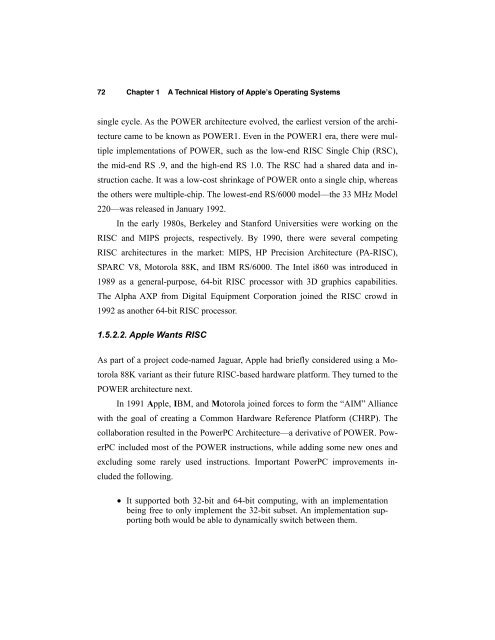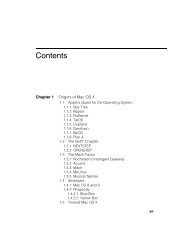A Technical History of Apple's Operating Systems - Mac OS X Internals
A Technical History of Apple's Operating Systems - Mac OS X Internals
A Technical History of Apple's Operating Systems - Mac OS X Internals
You also want an ePaper? Increase the reach of your titles
YUMPU automatically turns print PDFs into web optimized ePapers that Google loves.
72 Chapter 1 A <strong>Technical</strong> <strong>History</strong> <strong>of</strong> Apple’s <strong>Operating</strong> <strong>Systems</strong><br />
single cycle. As the POWER architecture evolved, the earliest version <strong>of</strong> the archi-<br />
tecture came to be known as POWER1. Even in the POWER1 era, there were mul-<br />
tiple implementations <strong>of</strong> POWER, such as the low-end RISC Single Chip (RSC),<br />
the mid-end RS .9, and the high-end RS 1.0. The RSC had a shared data and in-<br />
struction cache. It was a low-cost shrinkage <strong>of</strong> POWER onto a single chip, whereas<br />
the others were multiple-chip. The lowest-end RS/6000 model—the 33 MHz Model<br />
220—was released in January 1992.<br />
In the early 1980s, Berkeley and Stanford Universities were working on the<br />
RISC and MIPS projects, respectively. By 1990, there were several competing<br />
RISC architectures in the market: MIPS, HP Precision Architecture (PA-RISC),<br />
SPARC V8, Motorola 88K, and IBM RS/6000. The Intel i860 was introduced in<br />
1989 as a general-purpose, 64-bit RISC processor with 3D graphics capabilities.<br />
The Alpha AXP from Digital Equipment Corporation joined the RISC crowd in<br />
1992 as another 64-bit RISC processor.<br />
1.5.2.2. Apple Wants RISC<br />
As part <strong>of</strong> a project code-named Jaguar, Apple had briefly considered using a Mo-<br />
torola 88K variant as their future RISC-based hardware platform. They turned to the<br />
POWER architecture next.<br />
In 1991 Apple, IBM, and Motorola joined forces to form the “AIM” Alliance<br />
with the goal <strong>of</strong> creating a Common Hardware Reference Platform (CHRP). The<br />
collaboration resulted in the PowerPC Architecture—a derivative <strong>of</strong> POWER. Pow-<br />
erPC included most <strong>of</strong> the POWER instructions, while adding some new ones and<br />
excluding some rarely used instructions. Important PowerPC improvements in-<br />
cluded the following.<br />
• It supported both 32-bit and 64-bit computing, with an implementation<br />
being free to only implement the 32-bit subset. An implementation supporting<br />
both would be able to dynamically switch between them.




